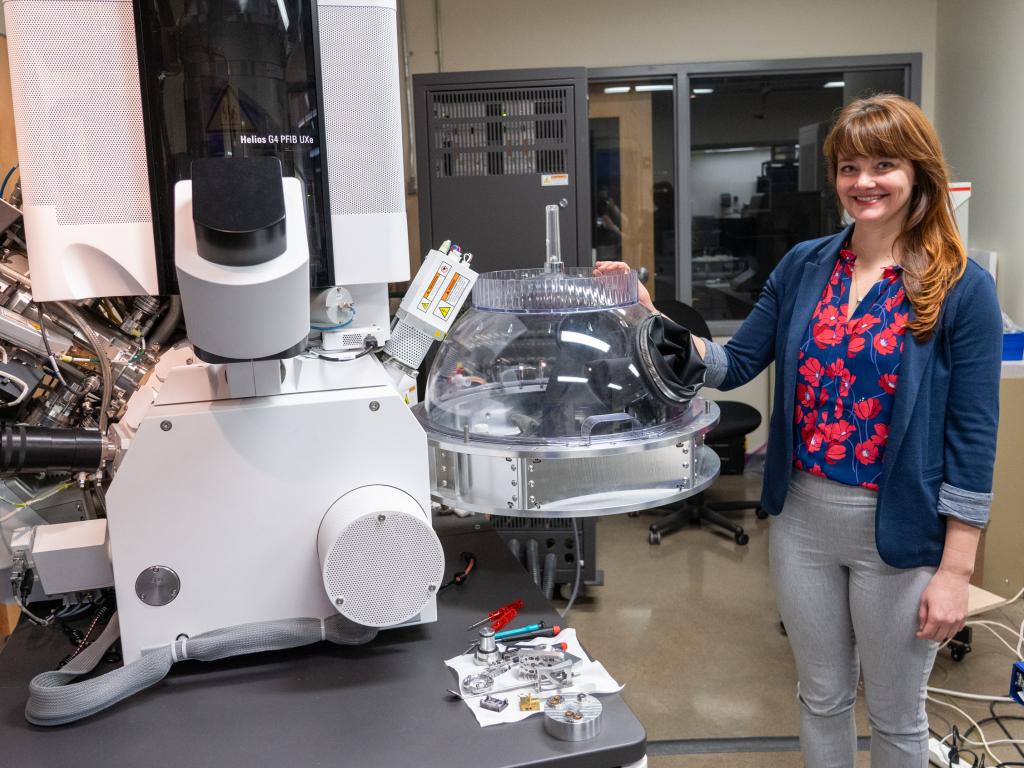
Certain materials, when exposed to air, corrode quickly or can even burst into flame. Yet these same materials, like lithium and sodium, are used for numerous chemical and electronic applications. The need to transfer sensitive samples from one environment to another without exposing them to air is crucial.
In the past, researchers have relied on expensive, bulky glove boxes or robotic systems that allow such transfers. However, these solutions come with drawbacks, such as limited sample movement and restricted compatibility with electron microscopes. The cost of glove boxes and robotics systems prevents many researchers from having access to such tools.
Enter the Noble DomeTM Air-Free Transfer system, which was invented at the University of Oregon. Designed as a cost-effective, compact, and user-friendly alternative, the Noble Dome offers scientists a streamlined method to handle sensitive samples without exposing them to air. Some scientists could use the dome to study battery samples to further improve energy storage. Others could analyze samples brought back from the moon or asteroids without exposing them to Earth’s oxidizing atmosphere.
Valerie Brogden, one of the Noble Dome’s inventors, noted that sometimes the simplest solution to a problem is the most elegant. Brogden is the Nanofabrication and Imaging Facility director in the Center for Advanced Materials Characterization in Oregon (CAMCOR). Her research often involves the transfer of sensitive samples into the vacuum chambers of advanced microscopes, and the idea for the Noble Dome was sparked by her own need.
“Instead of a standalone glove box, we married the box to the microscope,” she said. “You don’t always need overly high-tech equipment. This invention is so cool because it’s an elegant, simple solution.”
The Noble Dome Protects Samples and People
The Noble Dome, a transparent dome with gloves attached, enables researchers to move sensitive samples directly into a microscope’s vacuum chamber without the risk of air exposure. Its structure and functionality simplify the traditional setup: a dome-shaped enclosure attaches directly to the microscope, forming a sealed environment where samples packaged in inert gases can be safely transferred into the chamber. Using a noble gas like argon, the system ensures that reactive samples such as lithium and sodium are preserved until analysis.

Unlike conventional transfer systems, the Noble Dome doesn't require a standalone glove box. Noble Dome standard models range from $8,000 to $40,000, though fully customized glove boxes with advanced features can cost more than $100,000. Traditional glove boxes, combined with robotic transfer mechanisms, come with limitations like electrical wiring that can impede motion if a sample needs to be repositioned. Additionally, many existing systems require samples to be contained in recessed pits with robotic lids, which can limit the quality of electron and X-ray signals and ultimately reduce the resolution achievable in microanalysis.
In addition to protecting the samples from air, the dome could help limit a researcher’s exposure to hazardous material during sample preparation. The inside of the dome can be used to simulate the atmospheric mixtures of other planets, as well.
I-Corps Program Helps Inventors Test Market, Interview Potential Buyers
While the Noble Dome’s design has already demonstrated its effectiveness at protecting samples at CAMCOR, its creators have commercialized the design. In addition to Brogden, Jeff Garman, senior research assistant and machinist in the Oregon Fabrication and Design facility (OFAD), designed and fabricated the microscope interface while Steve Wiemholt, CAMCOR instrument engineer, designed and built the gas system.
As an affordable and efficient alternative, the Noble Dome is accessible to a broader range of researchers, even those without extensive resources.
Their first sale was recently finalized.
“It’s exciting to take the dome from idea to reality to sale,” Brodgen said. “The Noble Dome was in development for years, and watching it come to fruition is so fulfilling.”
To take the Noble Dome from idea to reality, Brogden, Garman, Steve Wiemholt and Kurt Langworthy, director of CAMCOR and also an inventor, participated in the Innovation Corps (I-Corps) regional and national programs. Funded by the National Science Foundation, I-Corps programs guide academic entrepreneurs through market discovery and customer feedback, helping them determine if there’s a strong demand for their innovations. Using the Lean Startup model, the I-Corps process applies scientific methods to commercialization, requiring researchers to present a minimum viable product to potential customers and adjust based on feedback.
The Noble Dome team set a goal to interview more than 100 potential users, focusing on those in battery research, space weathering, and failure analysis. Initial responses from potential users have been overwhelmingly positive, with many researchers expressing interest in a streamlined, cost-effective air-free transfer system that eliminates the need for separate glove boxes or even different rooms separating samples from microscopes.
Through I-Corps, the team aims to further refine the Noble Dome based on customer insights, ensuring the final product meets practical research needs.
“The dream is to license the Noble Dome’s intellectual property to a major company, which could help bring this technology to laboratories worldwide,” Brogden said.
In the meantime, OFAD is fabricating domes. With a patent pending, the Noble Dome is well-positioned to make a significant impact.
The Noble Dome exemplifies how an academic invention can address a pressing scientific need by simplifying processes and reducing costs. This innovation has the potential to change how scientists approach sensitive sample analysis, making the process more accessible and efficient.
